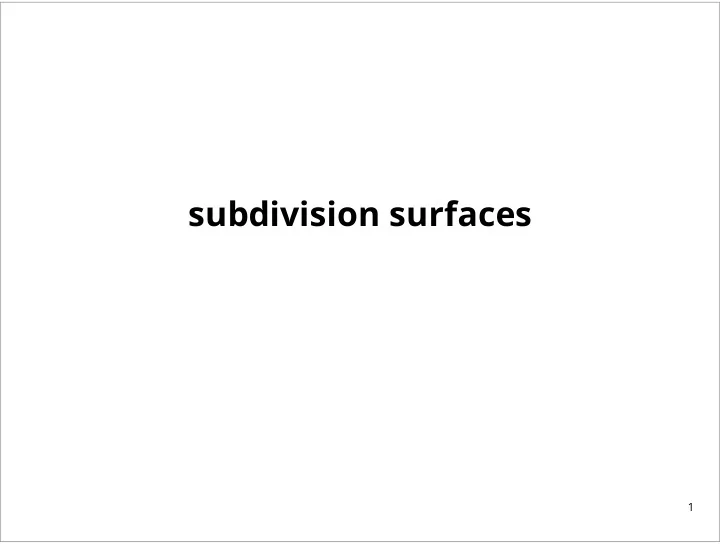

subdivision surfaces 1
subdivision curves start with a piecewise linear curve apply recursively subdivision rule [Zorin and Schröder, 2000] 2
subdivision surfaces start with polygon mesh apply recursively subdivision rule [Zorin and Schröder, 2000] 3
subdivision surfaces subdiv.: limit surface of subdivision process provably smooth subdivision process start with input mesh M 0 recursively apply subdivision rule : f M i +1 = f ( M i ) limit surface: lim i →∞ f i M 0 S = lim i →∞ M i = ( ) [DeRose et al.,1998] 4 [DeRose et al.,1998]
subdivision surfaces two stages: (1) refine mesh (2) place vertices mesh subdivision: new topology create new vertices and faces vertex placement: new geometry compute vertex position 5
subdivision surfaces different schemes available depend on input/output topology and geometry Catmull-Clark: quads meshes Loop: triangle meshes 6
catmull-clark step mesh subdivision: each quad is split in four quads [Zorin and Schröder, 2000] 7
catmull-clark step vertex placement: depends on where vertex originated [Zorin and Schröder, 2000] 8
loop step mesh subdivision: each triangle is split in four triangle [Zorin and Schröder, 2000] 9
loop step vertex placement: depends on where vertex originated [Zorin and Schröder, 2000] 10
loop vs. catmull-clark Loop Catmull-Clark [Zorin and Schröder, 2000] 11
loop vs. catmull-clark Loop Catmull-Clark [Zorin and Schröder, 2000] 12
loop vs. catmull-clark Base Loop Catmull-Clark [Zorin and Schröder, 2000] 13
loop vs. catmull-clark Loop Catmull-Clark [Zorin and Schröder, 2000] 14
editing manipulate original mesh while display subdiv local control 15
editing creases: can mark edges to be creased (subdivide as border) 16
editing creases: can mark vertices to be creased (do not move them) 17
editing creases: can mark both edges and vertices 18
subdiv usage heavily used in Computer Graphics old algorithms but practicalities introduced recently works well with animation arbitrary topology, no stitching Pixar’s Geri’s Game 1998 Catmull-Clark subdiv complex control mesh heavy use of creases (c) Pixar/Disney 19
surface representation comparison meshes -- implicit -- parametric -- subdiv accurate no yes yes yes concise no yes yes yes intuitive specification no no yes no local support yes no yes yes affine invariant yes yes yes yes arbitrary topology yes no no yes continuity no yes yes yes parameterization no no yes no efficient display yes no yes yes 20 efficient intersection no yes no no
implementing subdivision surfaces 21
implementing subdivision surfaces implementing subdiv notoriosly hard in standard formulation complex rules, requires data structures for adjacency reformulate as successive averaging based on A factored Approach to Subdivision Surfaces by Joe Warren and Scott Schaefer (download) subdivision requires more averaging passes to adjust position uses only a edge hash table; no complex data structures Loop, Catmull-Clark, mixed triangle/quad, creases 22 will discuss Catmull-Clark only
implementing catmull-clark subdiv step 1: linear subdivision 23
implementing catmull-clark subdiv step 1: linear subdivision create one vertex for each vertex, edge, quad in original vertex from vertex: set same position P ′ = P v v vertex from edge: set in middle between endpoints P ′ = ( P e 0 + P e 1 )/2 e vertex from face: set to face centroid P ′ = ( P f 0 + P f 1 + P f 2 + P f 3 )/4 f vertex from edge: two faces share an edge, but we canonot duplicate use hash table to check if already created 24
implementing catmull-clark subdiv step 1: linear subdivision create four faces for quad in original f ′0 P ′ f 0 P ′ f 1 P ′ f P ′ = ( , , , ) e e f 0 → f 3 → f 0 f ′1 P ′ f 1 P ′ f 2 P ′ f P ′ = ( , , , ) e e f 1 → f 0 → f 1 f ′2 P ′ f 2 P ′ f 3 P ′ f P ′ = ( , , , ) e e f 2 → f 1 → f 2 f ′3 P ′ f 3 P ′ f 4 P ′ f P ′ = ( , , , ) e e f 3 → f 2 → f 3 use hash table to find edge vertex index from two vertex indices 25
implementing catmull-clark subdiv step 2: averaging pass smooth vertex placement based on neightbors update vertex position as average of cetroid of faces touching it P ′′ P ′ = cetroid ( f , )/ count ( f ) for f such that i ∈ f i 26
implementing catmull-clark subdiv step 3: correction pass need to correct for vertices that have non-standard number of faces correct vertex position after linear subdivision with vertex position after averaging P ′′′ P ′ P ′′ P ′ = − ( − ) ⋅ (4/ count ( f )) 27
implementing catmull-clark subdiv // step 1: pseudocode for v in mesh->vertex: tesselation->add_vertex(v) for e in mesh->edge: if e not in hash: tesselation->add_vertex(centroid(e)) hash->add(e) for f in mesh->face: tesselation->add_vertex(centroid(f)) for f: in mesh->face: tesselation->add_face(...) tesselation->add_face(...) tesselation->add_face(...) tesselation->add_face(...) 28
implementing catmull-clark subdiv // step 2: pseudocode avg_v = new vertex[len(tesselation->vertex)] avg_n = new int[len(tesselation->vertex)] for v in avg_v: v <- 0 // init to zero for n in avg_n: n <- 0 // init to zero for f : tesselation->face: c = centroid(f) for v_index in f: avg_v[v_index] += c avg_n[v_index] += 1 for v_index in range(len(avg_n)): avg_v[v_index] /= avg_n[v_index] 29
implementing catmull-clark subdiv // step 3: pseudocode for v_index in range(len(tesselation->vertex)): avg_v[v_index] = tesselation->vertex[v_index] + (avg_v[v_index]-tesselation->vertex[v_index]) * (4/avg_n[v_index]) 30
Recommend
More recommend